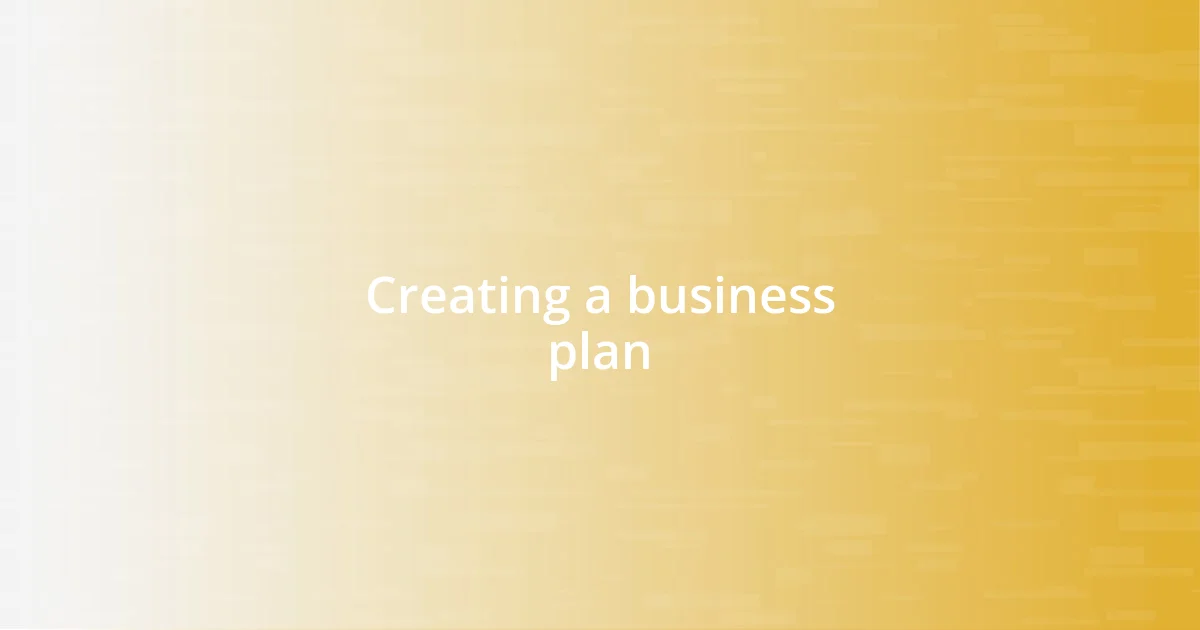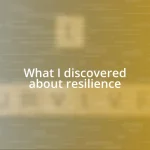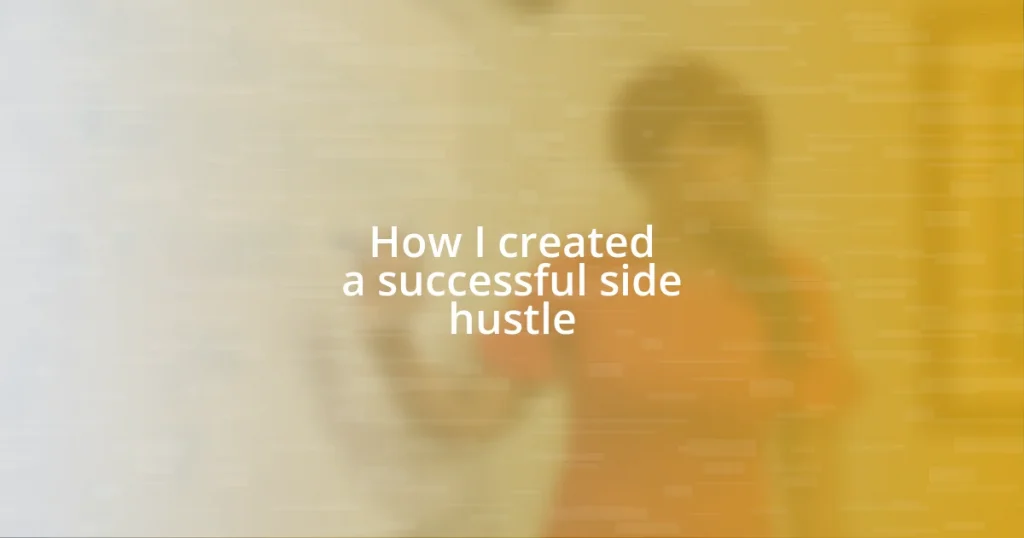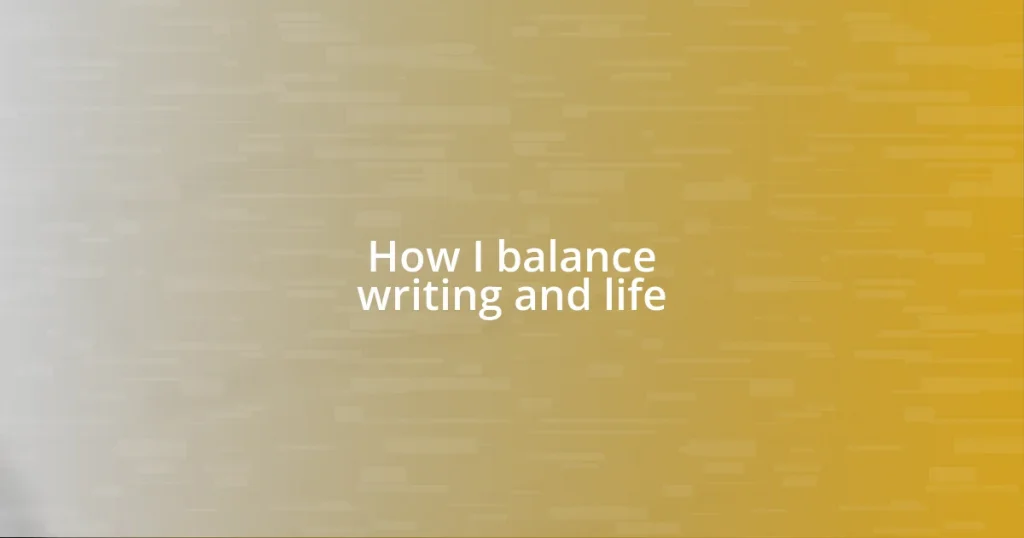Key takeaways:
- Identifying marketable skills involves recognizing natural talents and passions that can be transformed into profitable services.
- Understanding your target audience through surveys and feedback is crucial for tailoring marketing strategies and building authentic relationships.
- Setting clear financial goals and regularly adjusting your business plan are essential for navigating the challenges of a side hustle and ensuring sustainable growth.

Identifying marketable skills
Identifying marketable skills is like unearthing hidden treasures within yourself. I remember when I first realized my knack for graphic design; I had been creating flyers for local events just because I enjoyed it. One day, a friend asked me to help brand her business, which sparked the idea that what I loved doing could actually be a service others valued.
Think about the activities that come naturally to you. Have you ever been the go-to person for advice in a specific area? For me, it was writing. Friends would often ask for help with resumes or cover letters, and with each request, I realized that my skill in crafting compelling narratives could translate into a side hustle. I started small, offering my services on freelance platforms. The encouragement from my friends fueled my confidence and made me see my skills in a new light.
It’s worth noting that marketable skills often overlap with our passions. I continuously find joy in photography, and I wondered, “Could this be a side hustle too?” By slowly sharing my work on social media, I garnered interest that led to paid gigs. It felt empowering to convert a hobby into something profitable, affirming that our interests can indeed lead to successful ventures.

Analyzing your target audience
Understanding your target audience is a crucial step in creating a successful side hustle. I vividly recall the first time I really tuned in to who my audience was. I started sharing my freelance services on social media and noticed specific demographics engaging with my posts. It was like having a window into their world—seeing their interests, challenges, and aspirations. This insight made me rethink my marketing strategies, tailoring my message to resonate with them more deeply.
When I conducted surveys and gathered feedback, I was genuinely surprised by the responses. Some clients shared their struggles with finding approachable, relatable service providers, while others just wanted a connection based on shared interests. This experience reaffirmed my belief that effective communication goes beyond just selling a service; it’s about building relationships. Knowing the nuances of my audience helped me position my side hustle in a way that felt authentic and trustworthy.
In my journey, I discovered that even minor adjustments based on audience analysis could lead to significant results. For instance, after realizing my branding appealed largely to small business owners, I started incorporating testimonials from satisfied clients on my website. The relatable stories of real people created a sense of community and encouraged prospective clients to take that leap of faith and reach out. This pivotal shift not only resulted in more inquiries but also in becoming a go-to resource for their business needs.
| Analysis Method | Description |
|---|---|
| Surveys | Gather direct feedback from potential customers about their needs and preferences. |
| Social Media Insights | Analyze engagement metrics to understand what content resonates most with your audience. |
| Demographic Research | Identify key demographics that align with your service offerings. |

Setting clear financial goals
Setting clear financial goals is essential for guiding your side hustle journey. When I embarked on my own venture, I remember sitting down with a notebook and pen, trying to envision where I wanted to be financially. It was eye-opening to break my aspirations down into tangible, measurable goals. For me, starting with an initial target helped keep my focus sharp and my actions aligned with my desired outcomes.
Here are a few strategies I found helpful in establishing clear financial goals:
- Define Your Money Milestones: Set specific income targets for the first month, quarter, and year.
- Identify Key Expenses: Consider what costs are necessary to run your side hustle effectively.
- Establish a Savings Plan: Allocate a percentage of your earnings to a savings fund for reinvestment or emergencies.
- Track Your Progress Regularly: Use tools like spreadsheets or budgeting apps to monitor income and expenses consistently.
- Adjust Goals As Needed: Be flexible enough to reassess and shift your goals based on the market and personal circumstances.
The act of quantifying my financial aspirations not only motivated me but also gave me a sense of accountability. I vividly recall the excitement of hitting my first target—celebrating with a little treat for myself! It was in those moments that I truly realized how powerful setting clear financial goals can be. They serve as a roadmap, guiding decisions and ensuring that my passion for my side hustle translates into real financial rewards.

Creating a business plan
Creating a business plan is like sketching a map to your destination; it provides direction and clarity. When I crafted my first business plan, I remember feeling both nervous and excited. I laid out my vision, mission, and the specific objectives I wanted to achieve. It wasn’t just a formal document; it became a source of inspiration that fueled my determination every step of the way. Have you ever felt that rush when you realize your dreams are taking shape on paper? That’s what a robust business plan can do.
A solid plan should also identify your unique selling proposition. What sets you apart from the competition? For me, this was about infusing my personality into the services I offered. I focused on what I loved most and how that resonated with my audience. By articulating this in my business plan, I created a foundation that helped me stay authentic, even as the hustle evolved. Think about it—how do you want your audience to perceive you? Clarity on this can shape every decision you make.
Lastly, I cannot emphasize enough the importance of flexibility in your business plan. Life happens, and your market may shift unexpectedly. I remember a time when I had to pivot my offerings due to changing consumer needs. Instead of seeing it as a setback, I viewed it as an opportunity to innovate. Regularly reviewing and adjusting my business plan allowed me to navigate these changes with confidence. Does your plan allow for adaptation? If not, it might be time to rethink your approach.

Developing a marketing strategy
Developing a marketing strategy is one of the most crucial steps in my side hustle journey. I’m always amazed by how a solid marketing plan can transform a simple idea into a thriving business. When I first started out, I devoted time to research my target audience and identify where they were most active. This involved hours of scrolling through social media and even participating in online forums. I remember thinking, “What channels can I use to really connect with my potential customers?” It made all the difference when I tailored my efforts to the platforms they frequented.
Another aspect that helped me evolve my marketing strategy was embracing storytelling. I found that sharing personal anecdotes about my experience attracted people to my brand in a way that statistics and facts could never achieve. I vividly recall posting about a challenging moment I faced while trying to balance my side hustle with my day job. The response was overwhelming—instead of just gaining followers, I built a community that genuinely resonated with my journey. It made me wonder: how can you weave your story into your marketing efforts to create that same connection?
Lastly, I learned that testing different marketing techniques and measuring their success is vital. In the early days, I experimented with everything from social media ads to email newsletters. One campaign flopped so badly that I laughed at myself, wondering what I had missed. But each misstep was a valuable lesson. I now view analytics like a compass, guiding my decisions and helping me refine my approach. Have you considered how you measure success in your own marketing efforts? By being open to experimentation, I discovered what truly resonated with my audience and adjusted my strategy accordingly.

Balancing time and commitments
Balancing time and commitments is truly one of the most challenging parts of running a side hustle. I recall the days when I felt overwhelmed, squeezed between my full-time job and my growing side project. It often seemed like there weren’t enough hours in the day, and I had to learn to prioritize effectively. Have you ever felt that crunch where everything looks equally important? For me, it was about establishing a clear hierarchy of tasks and recognizing that not every fire needs to be put out immediately.
One strategy that worked well for me was setting strict boundaries around my time. I designated specific hours each evening for my side hustle, treating that time as non-negotiable. I still remember how liberating it felt to shut down distractions during those hours, allowing me to dive deep into my work. This rhythm not only boosted my productivity but also gave me the mental clarity to tackle challenges head-on. What boundaries might you need to establish in your own life to carve out time for what truly matters?
I also embraced tools that helped me stay organized and on track. Using digital planners became a game changer for managing my to-do list. One night, after feeling particularly flustered, I started using a project management app to divide my tasks into manageable chunks. Suddenly, what once felt like an insurmountable mountain turned into a series of small hills, all achievable. Have you considered how leveraging technology can streamline your efforts? By incorporating these tools into my routine, I felt more in control, which significantly reduced my stress and helped me maintain focus on my commitments.

Measuring success and adjusting
Measuring success in my side hustle journey was often a bumpy ride. Initially, I defined success through sales figures and follower counts. But my perspective shifted when I realized that engagement and customer feedback carried more weight. I vividly remember the first time I received a heartfelt message from a customer who felt my product changed their life. At that moment, I understood that true success isn’t just about numbers; it’s about the impact I’m making on others. Have you identified the deeper metrics that define success for you?
Adjusting my approach based on these insights became a continual process. I made it a habit to review my goals regularly—sometimes, I even did this over a cup of coffee, reflecting on what had worked and what hadn’t. I recall sitting in my favorite café and highlighting the victories and the setbacks in my planner. This ritual not only kept me grounded but also provided clarity. When was the last time you assessed your own achievements? This practice allowed me to pivot when necessary, like switching my marketing strategy after noticing I got more responses from video content than static posts.
It’s crucial to remember that adjustment isn’t a one-time event; it’s more like a dance. I learned to stay agile and responsive to changes in market trends and customer preferences. For instance, after attending a workshop on social media trends, I realized I needed to invest more in video creation. The first few videos I made were a bit awkward, and I felt embarrassed watching them back. Yet, with each new video, I noticed my confidence blossoming, along with my audience’s engagement. How do you adapt to new trends in your own work? Embracing this fluidity has been essential for me, reinforcing that success is as much about growth as it is about the destination.















